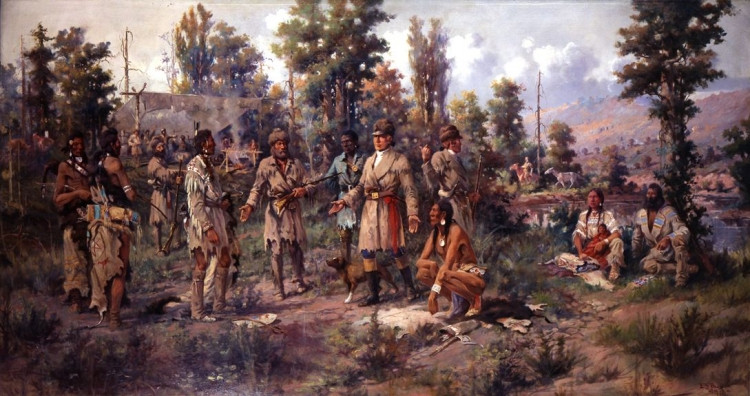Murals Of Edgar Paxson
June 13 2014 - September 6 2014
In an extremely rare opportunity, and on the 100th anniversary of the paintings’ installation at the courthouse, the Missoula Art Museum is proud to be able to display eight paintings by Edgar Paxon within our own Carnegie Gallery. The eight murals were removed in the fall of 2012 to make way for the Missoula County Courthouse’s, multi-year renovation and restoration project, and they will not be returned until sometime in 2015. This is a once-in-a-lifetime opportunity to view the paintings up close in a beautiful gallery setting.
When Missoula County’s courthouse, designed by local architect A.J. Gibson, opened for business in July of 1910, Missoulians admired its Neoclassical grace and symmetry but were unhappy with the interior’s stock decoration scheme of vegetation references and bland allegorical figures. The people of our fair city demanded that instead, artworks portraying “truly typical Montana pioneer life” be painted by a local artist who understood Montana history. The Missoula Women’s Club rallied public support for the project to be given to artist Edgar Samuel Paxson, and in 1912 the county commissioners engaged the beloved local artist and buddy of Buffalo Bill and Charlie Russell, to paint eight murals to be displayed in the courthouse’s grand entryway. On June 25, 1914, the completed murals were installed, followed in November by a public reception with 1,000 guests honoring the artist.
Paxson’s large-scale paintings depict in a grandiose manner some of the historic events that occurred in the area, including: Father Ravalli arriving at Fort Owen, the signing of the Hellgate Treaty the Salish people leaving the Bitterroot Valley for the Flathead Reservation, and three paintings featuring the Lewis and Clark Expedition. The paintings capture the spirit of the time, a nostalgic yearning for the bygone days of the heroic west, rendered with Paxson’s typical painstaking attention to detail of costume and accoutrement.
Paxson loved the beauty and majesty of Montana and admired its pioneer past. The son of a carriage builder, he arrived in Montana from New York State in 1877, just one year after the Battle of the Little Bighorn. By this time, the west was already industrializing and the U.S. government in the process of forcing native peoples onto reservations. Paxson mourned what he called “the passing of the Indian” and the taming of the wilderness, feeling he had just missed taking part in an heroic age. Perhaps he believed he was preserving this era with his grand, romantic paintings.
Missoula Art Museum would like to thank the Missoula County Commissioners for generously granting permission to display these important pieces of public art as Missoula celebrates its 150th birthday.


